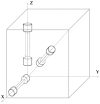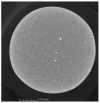Challenges in Additive Manufacturing of Space Parts: Powder Feedstock Cross-Contamination and Its Impact on End Products
- PMID: 28772882
- PMCID: PMC5459071
- DOI: 10.3390/ma10050522
Challenges in Additive Manufacturing of Space Parts: Powder Feedstock Cross-Contamination and Its Impact on End Products
Abstract
This work studies the tensile properties of Ti-6Al-4V samples produced by laser powder bed based Additive Manufacturing (AM), for different build orientations. The results showed high scattering of the yield and tensile strength and low fracture elongation. The subsequent fractographic investigation revealed the presence of tungsten particles on the fracture surface. Hence, its detection and impact on tensile properties of AM Ti-6Al-4V were investigated. X-ray Computed Tomography (X-ray CT) scanning indicated that these inclusions were evenly distributed throughout the samples, however the inclusions area was shown to be larger in the load-bearing plane for the vertical specimens. A microstructural study proved that the mostly spherical tungsten particles were embedded in the fully martensitic Ti-6Al-4V AM material. The particle size distribution, the flowability and the morphology of the powder feedstock were investigated and appeared to be in line with observations from other studies. X-ray CT scanning of the powder however made the high density particles visible, where various techniques, commonly used in the certification of powder feedstock, failed to detect the contaminant. As the detection of cross contamination in the powder feedstock proves to be challenging, the use of only one type of powder per AM equipment is recommended for critical applications such as Space parts.
Keywords: Additive Manufacturing; Ti-6Al-4V; cross contamination; microstructure; space applications; tensile properties.
Conflict of interest statement
The authors declare no conflict of interest.
Figures















Similar articles
-
Characterization of Composite Powder Feedstock from Powder Bed Fusion Additive Manufacturing Perspective.Materials (Basel). 2019 Nov 7;12(22):3673. doi: 10.3390/ma12223673. Materials (Basel). 2019. PMID: 31703412 Free PMC article.
-
Investigation of Microstructure and Mechanical Properties for Ti-6Al-4V Alloy Parts Produced Using Non-Spherical Precursor Powder by Laser Powder Bed Fusion.Materials (Basel). 2021 Jun 2;14(11):3028. doi: 10.3390/ma14113028. Materials (Basel). 2021. PMID: 34199584 Free PMC article.
-
Influence of Powder Bed Temperature on the Microstructure and Mechanical Properties of Ti-6Al-4V Alloy Fabricated via Laser Powder Bed Fusion.Materials (Basel). 2021 Apr 28;14(9):2278. doi: 10.3390/ma14092278. Materials (Basel). 2021. PMID: 33924888 Free PMC article.
-
A Critical Review on Effect of Process Parameters on Mechanical and Microstructural Properties of Powder-Bed Fusion Additive Manufacturing of SS316L.Materials (Basel). 2021 Oct 29;14(21):6527. doi: 10.3390/ma14216527. Materials (Basel). 2021. PMID: 34772048 Free PMC article. Review.
-
Additive manufacturing to veterinary practice: recovery of bony defects after the osteosarcoma resection in canines.Biomed Eng Lett. 2019 Jan 4;9(1):97-108. doi: 10.1007/s13534-018-00092-7. eCollection 2019 Feb. Biomed Eng Lett. 2019. PMID: 30956883 Free PMC article. Review.
Cited by
-
Cross-Contamination Quantification in Powders for Additive Manufacturing: A Study on Ti-6Al-4V and Maraging Steel.Materials (Basel). 2019 Jul 24;12(15):2342. doi: 10.3390/ma12152342. Materials (Basel). 2019. PMID: 31344794 Free PMC article.
-
Damage tolerant design of additively manufactured metallic components subjected to cyclic loading: State of the art and challenges.Prog Mater Sci. 2021 Aug;121:10.1016/j.pmatsci.2021.100786. doi: 10.1016/j.pmatsci.2021.100786. Prog Mater Sci. 2021. PMID: 34433989 Free PMC article.
-
Discrete Element Simulation of the Effect of Roller-Spreading Parameters on Powder-Bed Density in Additive Manufacturing.Materials (Basel). 2020 May 15;13(10):2285. doi: 10.3390/ma13102285. Materials (Basel). 2020. PMID: 32429173 Free PMC article.
-
Quantification of Interdependent Dynamics during Laser Additive Manufacturing Using X-Ray Imaging Informed Multi-Physics and Multiphase Simulation.Adv Sci (Weinh). 2022 Dec;9(36):e2203546. doi: 10.1002/advs.202203546. Epub 2022 Oct 31. Adv Sci (Weinh). 2022. PMID: 36316220 Free PMC article.
-
Composites Additive Manufacturing for Space Applications: A Review.Materials (Basel). 2022 Jul 5;15(13):4709. doi: 10.3390/ma15134709. Materials (Basel). 2022. PMID: 35806833 Free PMC article. Review.
References
-
- Wang F., Williams S., Colegrove P., Antonysamy A.A. Microstructure and Mechanical Properties of Wire and Arc Additive Manufactured Ti-6Al-4V. Metall. Mater. Trans. A. 2013;44:968–977. doi: 10.1007/s11661-012-1444-6. - DOI
-
- ISO/ASTM52900-15, Standard Terminology for Additive Manufacturing–General Principles–Terminology. ASTM International; West Conshohocken, PA, USA: 2015.
-
- Ghidini T., Pambaguian L., Blair S. Joining the Third Industrial Revolution: 3D Printing for Space. Volume 163. European Space Agency; Noordwijk, The Netherlands: 2015. pp. 24–33. European Space Agency Bulletin. - PubMed
-
- Lopatriello M., Gasbarri P., Paris C., Brotzu A., Paiano S. Thermo-mechanical characterization of a carbon micro-fibre reinforced polymer for additive manufacturing in space applications; Proceedings of the 66th International Astronautical Congress 2015: Space—The Gateway for Mankind’s Future (IAC); New York, NY, USA. 12–16 October 2015; pp. 6758–6766.
-
- Greitemeier D., Palma F., Syassen F., Melz T. Fatigue performance of additive manufactured TiAl6V4 using electron and laser beam melting. Int. J. Fatigue. 2017;44:211–217. doi: 10.1016/j.ijfatigue.2016.05.001. - DOI
LinkOut - more resources
Full Text Sources
Other Literature Sources
Research Materials

